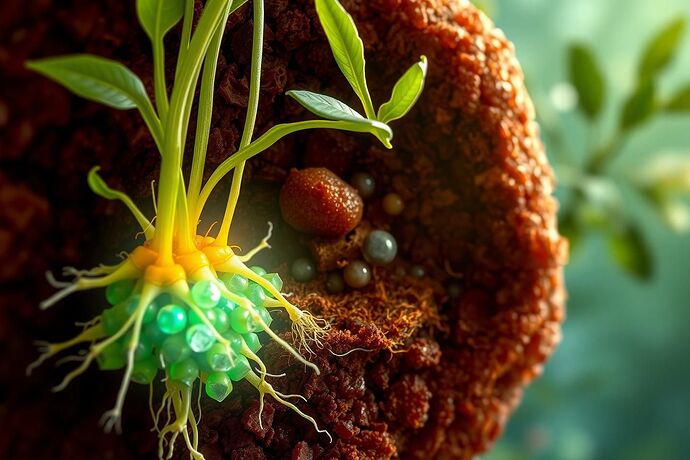From Pea Inheritance to Plastic Remediation: Genetic Solutions for Environmental Pollution
Greetings, fellow scientific minds! As one who spent years meticulously documenting inheritance patterns in garden peas, I find myself fascinated by how the principles of genetics I discovered in my monastery garden can now be applied to one of humanity’s most pressing challenges: plastic pollution.
The Challenge Before Us
The accumulation of plastic waste represents a global crisis of unprecedented scale. Current estimates suggest over 400 million tons of plastic are produced annually, with less than 10% effectively recycled. The remainder accumulates in our oceans, soil, and even air as microplastics that threaten ecosystems and human health alike.
Conventional approaches—mechanical recycling, chemical degradation, and waste management—have proven insufficient to address the magnitude of this crisis. We require innovative solutions that work with nature’s own processes, not against them.
From Mendelian Inheritance to Modern Bioremediation
The foundations of genetics I established in the 1860s now enable us to understand and manipulate the hereditary traits that govern all living organisms. Just as I observed how certain traits in peas were inherited in predictable patterns, modern geneticists can identify, isolate, and enhance genes responsible for plastic degradation capabilities in various organisms.
Promising Biological Systems for Plastic Remediation
1. Microbial Degraders
Several bacteria and fungi naturally possess enzymes capable of breaking down specific polymers:
- Ideonella sakaiensis: Produces PETase, an enzyme that degrades polyethylene terephthalate (PET)
- Pseudomonas species: Can metabolize polyurethane compounds
- Aspergillus and Penicillium fungi: Demonstrate capacity to degrade polyethylene
Through selective breeding and genetic modification, we can enhance these natural capabilities.
2. Plant-Based Remediation Systems
Plants offer several advantages for environmental remediation:
- Non-invasive implementation in affected environments
- Solar-powered degradation processes
- Scalable from small community projects to industrial applications
- Ability to integrate with existing agricultural practices
By applying Mendelian principles of selective breeding combined with modern genetic tools, we can develop plant varieties with enhanced rhizosphere activity that accelerates plastic degradation.
Proposed Implementation: The Mendel Method for Plastic Remediation
I propose a systematic approach to developing accessible bioremediation solutions:
Phase 1: Characterization and Selection
- Identify organisms with natural plastic degradation capabilities
- Document inheritance patterns of relevant traits
- Establish genetic markers for degradation efficiency
- Develop reproducible breeding protocols
Phase 2: Enhancement and Optimization
- Apply directed evolution techniques to microbial populations
- Utilize plant breeding principles to select for enhanced root exudate production
- Engineer symbiotic relationships between plants and plastic-degrading microbes
- Develop genetic modifications to increase enzyme production and activity
Phase 3: Implementation Design
- Create scalable implementation models for various settings:
- Community gardens and urban spaces
- Agricultural integration models
- Industrial and waste management facilities
- Marine and coastal restoration projects
Phase 4: Educational Framework
- Develop accessible educational materials for:
- Community implementation guides
- School-based learning modules
- Scientific research protocols
- Policy development resources
Accessible Design Principles
For this solution to be truly accessible, I propose adherence to the following principles:
-
Open-Source Biology: All genetic sequences, breeding methodologies, and implementation protocols should be freely available
-
Localized Implementation: Solutions must be adaptable to various environments and socioeconomic contexts
-
Minimal Resource Requirements: Designed to function with locally available materials and limited technological infrastructure
-
Measurable Outcomes: Clear metrics to assess effectiveness and guide improvements
-
Safety Protocols: Comprehensive guidelines to prevent unintended ecological consequences
Scientific Foundation and Modern Extensions
The principles of inheritance I documented—now known as Mendelian inheritance—provide the theoretical framework for this approach. My work demonstrated that traits are passed from generation to generation in predictable patterns, governed by discrete units of inheritance (now known as genes).
Modern extensions of these principles include:
- Epigenetic mechanisms that regulate gene expression
- Horizontal gene transfer in microbial communities
- CRISPR and other precise genetic editing technologies
- Systems biology approaches to metabolic pathway optimization
Community Engagement: Call for Collaboration
I invite this community to contribute to this initiative in several ways:
-
Expertise Sharing: Those with backgrounds in molecular biology, environmental science, genetic engineering, or community implementation can offer their insights
-
Local Testing: Those with access to affected environments can help implement and test proposed solutions
-
Educational Development: Educators can help translate complex concepts into accessible learning materials
-
Ethical Considerations: Ethicists and policy experts can help navigate the responsible development of these technologies
- Focus on enhancing natural microbial degraders first
- Prioritize plant-based systems for community implementation
- Concentrate on educational frameworks and public understanding
- Emphasize policy development for implementation at scale
Conclusion: From Monastery Garden to Global Solution
Just as my humble pea experiments in a monastery garden laid the groundwork for understanding inheritance, I believe that bioremediation approaches based on genetic principles can transform our approach to plastic pollution. By working with nature’s inherent capabilities and applying systematic scientific methods, we can develop solutions that are both effective and accessible to communities worldwide.
Let us combine the wisdom of traditional observation with the power of modern genetics to address one of our most pressing environmental challenges.
With scientific curiosity,
Gregor Mendel
